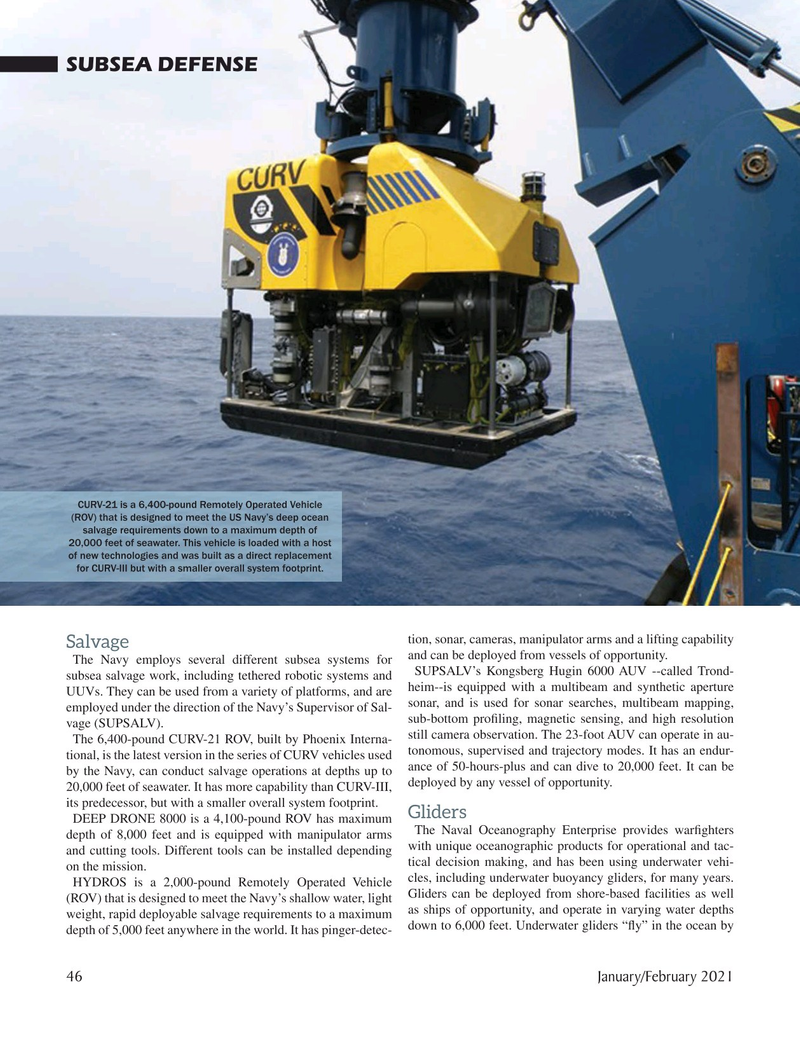
Page 46: of Marine Technology Magazine (January 2021)
Underwater Vehicle Annual
Read this page in Pdf, Flash or Html5 edition of January 2021 Marine Technology Magazine
SUBSEA DEFENSE
CURV-21 is a 6,400-pound Remotely Operated Vehicle (ROV) that is designed to meet the US Navy’s deep ocean salvage requirements down to a maximum depth of 20,000 feet of seawater. This vehicle is loaded with a host of new technologies and was built as a direct replacement for CURV-III but with a smaller overall system footprint.
tion, sonar, cameras, manipulator arms and a lifting capability
Salvage
The Navy employs several different subsea systems for and can be deployed from vessels of opportunity.
SUPSALV’s Kongsberg Hugin 6000 AUV --called Trond- subsea salvage work, including tethered robotic systems and
UUVs. They can be used from a variety of platforms, and are heim--is equipped with a multibeam and synthetic aperture sonar, and is used for sonar searches, multibeam mapping, employed under the direction of the Navy’s Supervisor of Sal- sub-bottom pro? ling, magnetic sensing, and high resolution vage (SUPSALV).
still camera observation. The 23-foot AUV can operate in au-
The 6,400-pound CURV-21 ROV, built by Phoenix Interna- tonomous, supervised and trajectory modes. It has an endur- tional, is the latest version in the series of CURV vehicles used by the Navy, can conduct salvage operations at depths up to ance of 50-hours-plus and can dive to 20,000 feet. It can be deployed by any vessel of opportunity.
20,000 feet of seawater. It has more capability than CURV-III, its predecessor, but with a smaller overall system footprint.
Gliders
DEEP DRONE 8000 is a 4,100-pound ROV has maximum
The Naval Oceanography Enterprise provides war? ghters depth of 8,000 feet and is equipped with manipulator arms and cutting tools. Different tools can be installed depending with unique oceanographic products for operational and tac- tical decision making, and has been using underwater vehi- on the mission.
HYDROS is a 2,000-pound Remotely Operated Vehicle cles, including underwater buoyancy gliders, for many years.
Gliders can be deployed from shore-based facilities as well (ROV) that is designed to meet the Navy’s shallow water, light as ships of opportunity, and operate in varying water depths weight, rapid deployable salvage requirements to a maximum down to 6,000 feet. Underwater gliders “? y” in the ocean by depth of 5,000 feet anywhere in the world. It has pinger-detec- 46 January/February 2021
MTR #1 (34-49).indd 46 1/25/2021 8:45:12 AM

 45
45

 47
47
